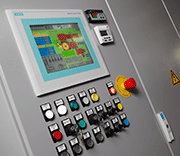E-Archive
Good Vibrations
in Vol. 16 - July Issue - Year 2015
Surface Mass Finishing 4.0

PLC control with Touch Screen at a Spaleck Oberfl

View into the electrical control unit, as seen via the elements of Bosch, one of the leading companies in the Industry 4.0 committee

A Spaleck Oberfl
The term "Industry 4.0" was first used in Germany. It was mentioned in 2011 at the Hanover Fair and describes technologies and concepts around the value chain organization. Different workgroups and non-profit organisations are working for research and standardisation results. In Germany, there is a Working Group on Industry 4.0 led by the Robert Bosch GmbH. In the United States, there is a similar organisation called "Smart Manufacturing Leadership Coalition". A very similar initiative by General Electric is called "The Industrial Internet", which brings together three elements: intelligent machines, advanced analytics and people at work.
The German term "Industry 4.0" refers to the fourth industrial revolution. The first revolution was the industrial production method with the help of water and steam. The second gained its force by electricity and the concepts of mass and assembly line production. The third was the digitization of the industry with the introduction of the microchip and modern computers. The fourth revolution will be the connection of the digital world of the internet with the classical industry world of machines and production facilities.
This German term of Industry 4.0 can be fundamentally described by six principles:
Interoperability (Communication across Internet of Things and of Services)
Virtualisation (linking sensor data (e.g. from observing physical results/processes) with simulation models
Decentralisation (connection of a system within a Smart Factory to make decisions on their own)
Real-Time Capability (ability to collect and analyse data)
Service Orientation (automatic offering of Services)
Modularity (flexible adaptation of Smart Factories to changing requirements)
In a column like the good vibrations, we are allowed to be bold enough to consider the possibilities of such concepts regarding their usability with surface finishing equipment. Let us try to make a check step by step:
Interoperability:
Fundamentally, this feature is for the most part reality in many larger mass-finishing installations offered today. Usually, modern PLC controls have the ability to be connected via Ethernet to personal computers and stream data from the machine to these computers. Manifold different solutions exist. Once the machine data are in a database, this information is also available to local area networks or even - if wished - to wide area networks.
Virtualisation:
This is in theory already possible but not used in the practical everyday life of mass finishing, as there are no methods using simulation models. A mass-finishing process is developed by a mixture of not-very-well documented process experience and trial-and-error concepts in manufacturing laboratories. No existing computer software is able to make reliable process proposals and interact with the machine to adapt the very specific processes.
Decentralisation:
In addition, this aspect is hard to carry out and is not realized today. The automatic decision by a computer as to which workpieces should run on a machine with a specified set of parameters is still science fiction in the mass-finishing world, because for such decisions, the experience and know-how of a human decision-maker is necessary.
Real-Time Capability:
This feature is commonly realized in larger surface-finishing installations. To collect data of part charges and volumes as well as machine status information like errors, run and standstill times are usually used. Of course, these data collections can be analysed by further software tools to find deeper insights for process optimization. It can even be streamed to remote and mobile devices of plant managers in real time. In addition, optical control via webcam of the machine is possible and sometimes used.
Service Orientation:
Earlier realized with modems but today mainly realized with VPN internet networks and a very powerful tool is the option of Remote Access to the machine. Therefore, the PLC control can send data directly to the manufacturer, if wished by the customer. This option unfolds many possibilities in the service area. The wear and tear of spare parts can be controlled by the customer or the manufacturer. So just in-time reactions without any standstill are feasible.
Modularity:
A smart factory that is able to configure the modules of a surface-finishing machine is hard to imagine in the near future. Nevertheless, surface-finishing machines are already using different modules of their own system according to the different programs in the PLC control. Moreover, the PLC control itself of course can communicate via the channel of the industrial Ethernet and specific middleware with future systems of a smart factory.
Finally, we can see that, already today, mainly two aspects of digital interlinking of surface finishing machines are really interesting: the real time data collection and analysis to monitor the finishing process in order to raise quality and system stability. The second part is the remote access on the data as well as the machine control for the customer and the manufacturer. The manufacturer of surface finishing equipment can offer better service and support for the customer. Both sides can profit enormously from these part aspects of 4.0 good vibrations.
Good Vibrations
by Mathieu Geuting
Spaleck Oberflächentechnik GmbH & Co. KG, Germany
Tel. +49.2871.9500 14
Fax +49.2871.9500 95
E-mail: m.geuting@spaleck.biz



























